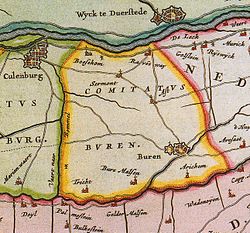County of Buren
The county of Buren (pronounced: Büren ) in what is now the Dutch province of Gelderland was an independent county until the founding of the Batavian Republic in 1795 , which was not formally part of the United Provinces of the Netherlands , but was nonetheless dependent on them.
timeline
The glory of Buren was created in 994 by splitting off from the county of Teisterbant and from then on was owned by Messrs. Van Buren . Their coat of arms became the coat of arms of the glory and the capital of Buren . Originally the High Glory consisted of the fortress town of Buren, to which the towns of Beusichem , Zoelmond , Buurmalsen and Tricht were inherited . In 1472 the Van Buren family was ousted from the Egmond family by the Gelderian dukes and in 1498 Emperor Maximilian I elevated the glory of Buren to a county. Later Emperor Karl V. wanted to raise Buren to the duchy, but Count Maximilian von Egmond refused with the following words: "Liever een rijke graaf, dan een arme hertog."
In 1551, Buren and the County of Leerdam came into the hands of the House of Orange-Nassau via Anna von Egmond-Buren . In 1795, when the Batavian Republic was proclaimed , all glorious rights were revoked and Buren lost its independence and the status of a county. Since then, the head of the House of Orange-Nassau (the Dutch head of state) has held the (honorary) title of graaf van Buren .
Counts of Buren
House Egmond
- 1492 (1498) -1521: Frederik von Egmond
- 1521–1539: Floris of Egmond
- 1539–1548: Maximilian von Egmond
- 1548–1558: Anna von Egmond-Buren , wife of Wilhelm I of Orange-Nassau
House of Orange-Nassau
- 1551–1584: Wilhelm I of Orange-Nassau
- 1584–1618: Philipp Wilhelm of Oranien-Nassau
- 1618–1625: Moritz von Oranien-Nassau
- 1625–1647: Friedrich Heinrich von Oranien-Nassau
- 1647–1650: Wilhelm II of Orange-Nassau
- 1650–1702: Wilhelm III. of Orange-Nassau
- 1702–1711: Johann Wilhelm Friso von Oranien-Nassau-Dietz
- 1711–1751: Wilhelm IV of Orange-Nassau-Dietz
- 1751–1795: Wilhelm V of Oranien-Nassau-Dietz

